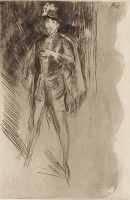Irving as Philip of Spain, No. 2 | ||
| Number: | 159 | |
| Date: | 1876/1877 | |
| Medium: | drypoint | |
| Size: | 228 x 155 mm | |
| Signed: | no | |
| Inscribed: | no | |
| Set/Publication: | 'Cancelled Plates', 1879 | |
| No. of States: | 6 | |
| Known impressions: | 22 | |
| Catalogues: | K.171; M.168; W.139 | |
| Impressions taken from this plate (22) | ||
KEYWORD
actor, full-length, man standing, portrait, theatrical.
TITLE
This is a portrait of Henry Irving (1838-1905) on stage; titles include the following:
'Irving' (1877, Charles Augustus Howell (1840?-1890)). 3
'Irving as Charles the First' (1890/1892, Beatrice Whistler (1857-1896)). 4
'Irving as Charles the First' (1886, Frederick Wedmore (1844-1921)). 5
'Irving as Philip of Spain, No. 2' (1909, Howard Mansfield (1849-1938)) 6
Beatrice Whistler was incorrect, since this definitely shows Irving as Philip, not Charles. The numbering adopted by Mansfield was considered necessary because there is another portrait of Irving in the same role, Irving as Philip of Spain, No. 1 [158]. Thus Irving as Philip of Spain, No. 2 is the generally accepted title, although there is no way of knowing which drypoint was done first.
'Irving' (1877, Charles Augustus Howell (1840?-1890)). 3
'Irving as Charles the First' (1890/1892, Beatrice Whistler (1857-1896)). 4
'Irving as Charles the First' (1886, Frederick Wedmore (1844-1921)). 5
'Irving as Philip of Spain, No. 2' (1909, Howard Mansfield (1849-1938)) 6
Beatrice Whistler was incorrect, since this definitely shows Irving as Philip, not Charles. The numbering adopted by Mansfield was considered necessary because there is another portrait of Irving in the same role, Irving as Philip of Spain, No. 1 [158]. Thus Irving as Philip of Spain, No. 2 is the generally accepted title, although there is no way of knowing which drypoint was done first.
3: Howell to Whistler, [6-15 November 1877], GUW #02178.
4: list, [1890/1892], GUW #12715.
5: Wedmore 1886 A (cat. no. 139).
6: Mansfield 1909 (cat. no. 168).
DESCRIPTION
Irving is standing, facing front, with his left hand raised to his chest, and his right arm extended to his side. He wears a hat with a white plume, a short cloak falling from his shoulders to mid-thigh, and pale coloured tights. The background is deeply shadowed.
SITTER
Henry Irving (1838-1905) was the subject of many prints and paintings. In 1875 he was etched by Percy Thomas (1846-1922), and the print was to be published by Jane Noseda (b. 1813 or 1814), who a couple of years later bought one of Whistler's drypoints of Irving. 7
He posed to Whistler in 1876 for Arrangement in Black, No. 3: Sir Henry Irving as Philip II of Spain [y187]. Wedmore wrote that the artist lacked enthusiasm for the drypoint: 'Mr. Whistler told me the work did not greatly interest him, as he felt he had already done with the subject in the painted picture. But it is full of character.' 8
He posed to Whistler in 1876 for Arrangement in Black, No. 3: Sir Henry Irving as Philip II of Spain [y187]. Wedmore wrote that the artist lacked enthusiasm for the drypoint: 'Mr. Whistler told me the work did not greatly interest him, as he felt he had already done with the subject in the painted picture. But it is full of character.' 8
7: The Academy, 10 July 1875, p. 49; Howell to Whistler, [1877?], GUW #02181.
8: Wedmore 1886 A (cat. no. 139).
DISCUSSION
This is one of several subjects, including portraits, related to the theatre. Whistler's oil painting of Irving was radically changed several times over a considerable period. The drypoint portraits are related to the early composition of the portrait in 1876-1877, where the sitter does not wear a chain round his neck, and has no garter. Furthermore, the cloak that hung loosely from Irving's shoulders in the earlier state is shown in the finished composition of about 1885 as thrown forward over the sitter's right shoulder. 9
9: YMSM 1980 (cat. no. 187).
Whistler was not entirely successful when he tried to make prints related to portraits, such as his later lithographic version of his oil of Robert de Montesquiou-Fezensac (1855-1921). The Pennells wrote:
'A plate was made from the Irving as Philip of Spain, the only one of his portraits that Whistler reproduced on copper, and he did it very badly ... He was bored to death with copying himself, and twenty years afterwards, when he undertook to make a lithograph of his Montesquiou, and failed, he said that "it was impossible to produce the same masterpiece twice over", that "inspiration would not come," that when he was not working at a new thing from Nature, he was not applying himself, "it was as difficult as for a hen to lay the same egg twice."' 10
10: Pennell 1908, I, p. 215; Count Robert de Montesquiou, No. 2 [c084] and Count Robert de Montesquiou [c085].
